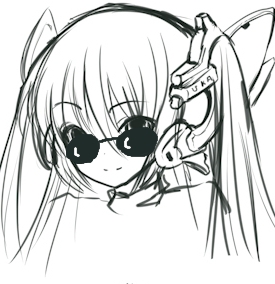
Written by Martin Butler on 27 Apr 2006
Distributor Tokyopop • Author/Artist Hajime Ueda (Gainax) • Price £5.99
Studio Gainax have something of a reputation for taking risks and working on projects that are rather unconventional. The six part OVA of FLCL (a.k.a. Fooly Cooly) was no exception: combining offbeat humour, sharp visuals, a brilliant soundtrack and heartfelt coming-of-age themes, it stands as one of the most popular animated comedy-dramas of recent years. An in-print adaptation therefore has its work cut out in trying to match the inventiveness and manic vibe of the original series.
In the town of Mabase a young baseball player has left for pastures new in the USA; his kid brother Naota has stayed with his family in a state of bored cynicism, having having no clear idea of what to do with his life. His absent brother’s girlfriend won’t leave him alone, his father and grandfather are no help whatsoever and there are strange goings-on in the new factory that dominates the skyline. When a strange young woman on a Vespa clobbers him over the head with a bass guitar things begin to become even stranger - robots start growing out of Naota’s head, but this is just the start…
Right from the first page Hajime Ueda’s artwork is really striking: capturing the feel of the story through static images was always going to be quite a challenge but the rough sketchy drawing style pulls it off brilliantly. It takes a bit of getting used to at first and it does make things a little difficult to follow in places but it conveys the hero’s confusion very effectively. It is suitably distinctive and downright odd to be worthy of the FLCL name: nothing around right now looks quite like it.
In terms of the characters, they are really varied and engaging and quite a lot of effort is made into exploring their feelings and motives. Naota is a jaded onlooker for his bizarre life but at the same time shows genuine curiosity towards the countless questions and feelings that adolescence brings. Even the token high school student-type supporting characters are given some individuality and Naota’s family are sure to raise a few laughs. Haruko, the Vespa-riding, bass wielding source of Naota’s troubles is in great contrast to the air-headed Mamimi, the former girlfriend of Naota’s brother and main source of concern before Haruko bursts into his life. Although apparently insane, Haruko’s intentions are by no means obvious and her actions only add to the apparent randomness of the story in general.
The original OVA made a strong point of having method in the madness however, and portrayed some serious themes and references to other anime shows through symbols and metaphors that were not obvious at first glance. This is retained in the manga adaptation (there are one or two Evangelion references if you look carefully) but while this version retains much of the show’s charm it hasn’t kept the cohesiveness of the storyline. The events that unfold jump around in time and place (not helped by the strange chapter number labelling), making for a heavy-going reading experience. The ending in particular ends up feeling quite disjointed and abrupt and it is difficult to draw any satisfying conclusions from it.

posted by Ross Locksley on 31 Dec 2024
posted by Eoghan O'Connell on 13 Dec 2024
posted by Ross Locksley on 12 Dec 2024
posted by Ross Locksley on 11 Dec 2024
posted by Eoghan O'Connell on 04 Dec 2024
posted by Eoghan O'Connell on 28 Nov 2024
posted by Ross Locksley on 08 Oct 2024
posted by Ross Locksley on 25 Sep 2024